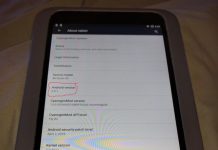 I saw the Edge at breakfast with Entourage during the Publishing Expo and was pretty impressed. As a matter of fact, I’ve given some consideration to buying one for myself. The Edge is clearly aimed at the student market – even including such things as a microphone so a student can record his lecture – but there are a lot of things that are of interest to regular people as well.
I saw the Edge at breakfast with Entourage during the Publishing Expo and was pretty impressed. As a matter of fact, I’ve given some consideration to buying one for myself. The Edge is clearly aimed at the student market – even including such things as a microphone so a student can record his lecture – but there are a lot of things that are of interest to regular people as well.
The Entourage people told me that the Edge was inspired by them watching their kids lug heavy backpacks back and forth. The Edge’s form factor and functionality was partly designed as a result of focus groups held at two universities and also with the help of college-aged interns. As a result of input from high school students the button placement on the unit was changed from their original idea. All software development and QA is done in-house and the start-up is self-funded. Their original plan was to sell solely to the education market, but Entourage has found significant interest in the areas of business, document management, remote field forces and forms management.
The touch portion is a Wacom digitizer and so the included stylus has to be used. I mentioned the high cost of the unit for students and Entourage replied that with the reduced costs of the etextbooks the students would be buying to use on it the ROI should be two years. Battery life is, they said, about 6 hours with both screens and WiFi on. The goal is to have enough battery life to last for a whole school day. The Edge has two microphones and one of them is used for active noise cancellation to get a clear recording.
The Engadget review says that the Edge can’t download Android apps, but this is not what the Edge people told me. As a matter of fact they had an HP calculator running on the machine. The unit is manufactured by Foxcon.
Engadget gives the Edge fairly weak marks and you should go over and read it. I didn’t have the machine long enough comment on their conclusions, but it is a fascinating device that certainly has a lot of potential. Your best bet for seeing and playing with one would be to check with a university bookstore near you.

































Wow. That was a pretty lame review by Engadget. They barely even get into any details about how the Edge operates. More after the break . . .
Paul gives 5x more relevant info in the above article.
All they do is compare it to other devices and complain about features that aren’t available yet or that they aren’t smart enough to figure out.
Didn’t learn a single thing that I didn’t already know from reading articles published before its release. Geesh. I give Engadget weak marks on that review.
Yes, the Endgadget review it too focused on what’s NOT there rather than describing what IS. In particular there’s very little discussion of the points where the device really shines and stands out: interaction of two screens, working with PDFs, portable office/classroom use. (See my own comparison of pros/cons compared to Kindle DX, iPad, and tablet PC http://u.nu/8snk7)
Here’s a more balanced view of the criticisms stated in the article:
1. Device size/weight – obviously this is heavier/bigger than a Kindle DX, but since it has twice the screen real estate and much more functionality than any other ereader out there I think it’s a bit of an unfair comparison. Clearly this is not meant for handholding it for extended period of time.
2. Slow stylus annotation/writing – not sure the reviewer had the auto- smoothing and background lines turned off, early reports suggest this greatly improves the e-ink speed. The fact that stylus works on the E-ink side is pretty amazing to begin with, and most reports I’ve seen have praised this function as working really well.
3. Poor battery life – maybe the spec 6 hrs (LCD + e-ink) to 16 hours (e-ink) is actually lower, but I haven’t seen much evidence of that so far. If the specs are true, then I’d consider that pretty good battery life, enabling a full day of classes / office use with charging overnight. The battery life is comparable to netbooks and better than a laptop, which I think is quite good for a two-screen device. For those super-long days, it might be worth investing in a second battery.
4. Inadequate bookstore – yes, the Entourage bookstore doesn’t offer the widest selection, but you can buy books elsewhere (Adobe Digital Editions) too. More importantly, the device seems targeted to students and office professionals who deal with a lot of PDFs. There is obviously no way for a startup to compete with Amazon or B&N on content, so their efforts in this area (including some newly announced periodicals deals) should be applauded, but will never be a core strength of the device.
5. Frustrating touchscreen experience – can’t really comment on this, since my device hasn’t arrived yet, but it might largely be a matter of getting used to. Remember when you got your iPhone how you could barely type a word on that virtual keyboard? What I do know is that the absence of touch on my Kindle DX really is annoying, and that tiny “real” keyboard at the bottom is a joke. Just about anything is better than that.
6. Non-functioning hardware – Ok, it’s definitely odd to get a unit with bluetooth, camera and flash lite support promised via software update in the unspecified future. But Entourage — a startup — should get lots of credit for actually shipping a device while huge companies can only manage vaporware videos ([cough] MS Courier [cough]). We’ve heard about Plastic Logic’s QUE reader for years now – now the ship date has been pushed back AGAIN.
7. Lack of Android apps – okay, lack of Android Marketplace (coming soon, from what I understand) is a bummer for now, although apps CAN be downloaded from developer sites (which the review does not mention). Even more of a bummer is the fact that there just aren’t a huge number of Android apps (compared to windows or iphone) and those that are out there are generally not programmed to take advantage of the eDGe’s screen size. I’m hopeful, though, that as Android tablets gain in popularity, people will develop apps for it.
Overall, as a cutting-edge device (no pun intended) the device has a number of kinks to work out and may not be right for everyone, but I’m sure glad it’s out there since it looks to be exactly the type of thing I’ve been looking for to use as a lawyer who works with a lot of PDFs.
For what it’s worth, I’ve contacted Entourage about getting a review unit myself. (I did so before this was posted, so I didn’t realize Paul had an interest in the device at the time.) They said they would let me know when they had one for me to borrow.
Watched the demo at the Entourage website. I’m very impressed with the dual screens and note-taking functions. I’ve busted my gadget budget but this is going on the wish list.
So … it doesn’t get more text on the screen than the un-average 6″ reader even though it has about 2.5 times the square inch screen area? Hehe. 😉
Thanks for this posting. I am interested in an ebook reader that will be useful for students/researchers. It sounds promising, but Entourage should know that most college student’s days are longer than 6 hours. Many students stack their classes so they can squeeze in work, internships, etc. One also assumes–perhaps foolishly– that they read after class.
This seems to be very much a 1.0 version electronic gizmo. But the price is terrific for what you get. I wish them all the success in the world, and look forward to version 2.0.
— asotir